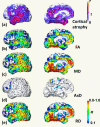Distinctive disruption patterns of white matter tracts in Alzheimer's disease with full diffusion tensor characterization
- PMID: 21872362
- PMCID: PMC3227739
- DOI: 10.1016/j.neurobiolaging.2011.06.027
Distinctive disruption patterns of white matter tracts in Alzheimer's disease with full diffusion tensor characterization
Abstract
To characterize the white matter structural changes at the tract level and tract group level, comprehensive analysis with 4 metrics derived from diffusion tensor imaging (DTI), fractional anisotropy (FA), mean diffusivity (MD), axial diffusivity (AxD) and radial diffusivity (RD), was conducted. Tract groups, namely limbic, commissural, association, and projection tracts, include white matter tracts of similar functions. Diffusion tensor imaging data were acquired from 61 subjects (26 Alzheimer's disease [AD], 11 subjects with amnestic mild cognitive impairment [aMCI], and 24 age-matched controls). An atlas-based approach was used to survey 30 major cerebral white matter tracts with the measurements of FA, MD, AxD, and RD. Regional cortical atrophy and cognitive functions of AD patients were also measured to correlate with the structural changes of white matter. Synchronized structural changes of cingulum bundle and fornix, both of which are part of limbic tract group, were revealed. Widespread yet distinctive structural changes were found in limbic, commissural, association, and projection tract groups between control and AD subjects. Specifically, FA, MD, and RD of limbic tracts, FA, MD, AxD, and RD of commissural tracts, MD, AxD, and RD of association tracts, and MD and AxD of projection tracts are significantly different between AD patients and control subjects. In contrast, the comparison between aMCI and control subjects shows disruption only in the limbic and commissural tract groups of aMCI subjects. MD values of all tract groups of AD patients are significantly correlated to cognitive functions. Difference between AD and control and that between aMCI and control indicates a progression pattern of white matter disruption from limbic and commissural tract group to other tract groups. High correlation between FA, MD, and RD measurements from limbic tracts and cortical atrophy suggests the disruption of the limbic tract group is caused by the neuronal damage.
Copyright © 2012 Elsevier Inc. All rights reserved.
Figures







Similar articles
-
Microstructural white matter changes, not hippocampal atrophy, detect early amnestic mild cognitive impairment.PLoS One. 2013;8(3):e58887. doi: 10.1371/journal.pone.0058887. Epub 2013 Mar 14. PLoS One. 2013. PMID: 23516569 Free PMC article.
-
Comparison of diffusion tensor image study in association fiber tracts among normal, amnestic mild cognitive impairment, and Alzheimer's patients.Neurol India. 2011 Mar-Apr;59(2):168-73. doi: 10.4103/0028-3886.79129. Neurol India. 2011. PMID: 21483111
-
Relationship Between DTI Metrics and Cognitive Function in Alzheimer's Disease.Front Aging Neurosci. 2019 Jan 9;10:436. doi: 10.3389/fnagi.2018.00436. eCollection 2018. Front Aging Neurosci. 2019. PMID: 30687081 Free PMC article.
-
Diffusion tensor imaging in Alzheimer's disease and mild cognitive impairment.Behav Neurol. 2009;21(1):39-49. doi: 10.3233/BEN-2009-0234. Behav Neurol. 2009. PMID: 19847044 Free PMC article. Review.
-
The role of diffusion tensor imaging and fractional anisotropy in the evaluation of patients with idiopathic normal pressure hydrocephalus: a literature review.Neurosurg Focus. 2016 Sep;41(3):E12. doi: 10.3171/2016.6.FOCUS16192. Neurosurg Focus. 2016. PMID: 27581308 Review.
Cited by
-
Conductance-Based Structural Brain Connectivity in Aging and Dementia.Brain Connect. 2021 Sep;11(7):566-583. doi: 10.1089/brain.2020.0903. Epub 2021 May 27. Brain Connect. 2021. PMID: 34042511 Free PMC article.
-
Evaluation of Visual-Evoked Cerebral Metabolic Rate of Oxygen as a Diagnostic Marker in Multiple Sclerosis.Brain Sci. 2017 Jun 11;7(6):64. doi: 10.3390/brainsci7060064. Brain Sci. 2017. PMID: 28604606 Free PMC article.
-
The effect of hippocampal function, volume and connectivity on posterior cingulate cortex functioning during episodic memory fMRI in mild cognitive impairment.Eur Radiol. 2017 Sep;27(9):3716-3724. doi: 10.1007/s00330-017-4768-1. Epub 2017 Mar 13. Eur Radiol. 2017. PMID: 28289940 Free PMC article.
-
Imaging the accumulation and suppression of tau pathology using multiparametric MRI.Neurobiol Aging. 2016 Mar;39:184-94. doi: 10.1016/j.neurobiolaging.2015.12.001. Epub 2015 Dec 15. Neurobiol Aging. 2016. PMID: 26923415 Free PMC article.
-
Amyloid burden accelerates white matter degradation in cognitively normal elderly individuals.Hum Brain Mapp. 2019 May;40(7):2065-2075. doi: 10.1002/hbm.24507. Epub 2019 Jan 3. Hum Brain Mapp. 2019. PMID: 30604903 Free PMC article.
References
-
- Acosta-Cabronero J, Williams GB, Pengas G, Nestor PJ. Absolute diffusivities define the landscape of white matter degeneration in Alzheimer’s disease. Brain. 2010;133:529–539. - PubMed
-
- Alexander AL, Hasan KM, Lazar M, Tsuruda JS, Parker DL. Analysis of partial volume effects in diffusion-tensor MRI. Magn. Reson. Med. 2001;45:770–780. - PubMed
-
- Akaike H. A new look at the statistical model identification. IEEE Transactions on Automatic Control. 1974;19:716–723.
-
- Ashburner J, Friston KJ. Voxel-Based Morphometry--The Methods. NeuroImage. 2000;11:805–821. - PubMed
-
- Ashburner J, Friston KJ. Why Voxel-Based Morphometry Should Be Used. NeuroImage. 2001;14:1238–1243. - PubMed
Publication types
MeSH terms
Grants and funding
LinkOut - more resources
Full Text Sources
Medical
Miscellaneous

